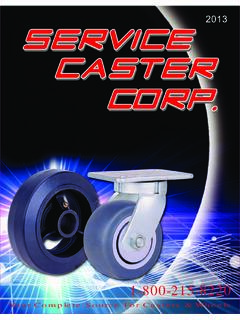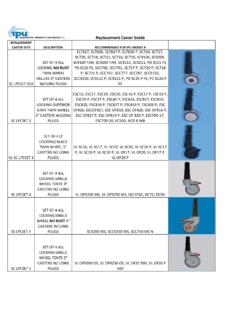Transcription of The MUNCASTER steam-engine models - 8
1 The MUNCASTER steam - engine models - 8 Continued from 16 May 1957, pages 700 to 702In this instalment EDGAR T. WESTBURY discusses governors and control gearSEVERALLof the engine designsin this series have includedgovernor gear, which is anecessary fitting for engines whichhave to maintain a fairly constantspeed under varying load conditionsand, in fact, practically any enginewhich is not under the constantsupervision of the all steam - engine governorsare of the centrifugal type, based onthe original pendulum governor ofJames Watt, and.
2 In the earlier enginesat least, were usually made as a self-contained unit, located at a con-venient position on the engine to bedriven by belt or gears, and forconnecting up to a throttle controlvalve. I have described governormechanism in connection with theUnicorn and Tangye engines as well asin a separate artical [ model ENGINEER,27 October 1955] dealing with agovernor unit suitable for the Vulcanbeam engine or other early the basic principle of thegovernor is very easy to grasp-indeed.
3 It is obvious to anyone whohas observed the forces exerted inrotating masses-a full explanation ofthe theoretical considerations involvedin its design would take up far morespace than could be spared text books on mechanicsusually devote one or two pages ofmathematical formulae to the pheno-mena of centrifugal force (for example,see Ganot s Physics, para. 55), butMODEL ENGINEERI propose to deal only with simplepractical applications of the governorin the examples illustrated by first designed by James Watt, therotating ball weights of the governornot only produced the positive operat-ing effort, under the effect of centri-fugal force, but also the negative orrestoring effort, under the effect ofgravity.
4 No extra weights or springswere used, and the vertical shaftarrangement was essential for itsoperation. MUNCASTER states that inthis form it cannot be recommendedfor small engines, and my own ex-perience supports this view; the reasonof course is that in a small size; thegravitational effect is reduced to amuch greater extent than the frictionin the working action of a governor relyingon the weight of the balls alone torestore the control on reduction ofspeed would be very erratic or sticky.
5 Some governors, such asthe Porter type, have an additionalmoving weight, which slides on thecentre shaft and supplements therestoring force, but even this is limitedin its effects and has been foundinadequate in small sizes. It is alsonecessary in most cases to increasethe positive effort by running smallgovernors at higher speed than thefull-size obvious method of increasingthe restoring effort is by fitting someind of spring. In theory, this com-plicates matters because there is adefinite difference between the actionof a spring and that of gravity, butin practice governors fitted withsprings work quite well.
6 The governorillustrated in Fig. 38 has a com-pression spring fitted on the centre shaft, which exerts pressure betweenthe fixed upper yoke from which theweight arms are suspended, and thelower sliding yoke carrying the groovedcollar which operates the control design has several features incommon with the governor of theTangye engine previously referred to,but the method of articulating thelinks is somewhat different. Insteadof forking the top ends to embracethe ball, the latter is made hollowand the link is made ball-ended tofit inside it.
7 In either case the pivotpin passes diametrically through thecentre of the is a very neatarrangement, but it decreases theweight of the ball substantially so thatit must be made larger to produce thesame centrifugal transmit the movement of thesliding yoke to the governor leverwith the minimum friction, a horse-shoe-shaped thrust collar is fitted tothe groove,with extended pivotsengaging the eyes of short arms whichstraddle the yoke and are pinnedto the lever shaft.
8 These details areillustrated in Fig. 39. The governorshaft runs in a long vertical bearing,in a bracket mounted on the engineframe, and is bevel-geared to theLeft, Fig. 39: De-tails of the link pivots and thrustcollar for the ver-tical-shaft governor __Right, Fig. 40: Ahorizontal spring-loadedgovernor suit-able for high-speedengines 77830 MAY 1957\drive shaft which runs in a longhorizontal high-speed engines, such asthose used for driving electricalgenerators, it is often found con-venient to fit the governor directlyon the end of the main shaft, thusavoiding the necessity for either beltor gear drive, and making a compactarrangement.
9 In this case springreturn is an obvious necessity, and itis also desirable to reduce the numberof working parts in the mechanism,thus cutting down wear, friction andany tendency to rattle. The governor(Fig. 40) fulfils these conditions, as itentails the use of only two pivotedjoints and a single sliding member,with a totally-enclosed central com-pression spring. This type is suitablefor the engine shown in Fig. will be seen that as the ballsmove outwards under the effect ofcentrifugal force, the bell crank leversto which they are attached pressagainst a fixed thrust washer, causingthe entire governor assembly to movebodily to the left.
10 The grooved collaron the sleeve operates the governorlever through a thrust collar, as inthe previous example, though this isnot shown. In the drawing, the shaftextension which carries the governoris shown as screwed into the end ofthe main engine shaft, but there arepractical objections to this arrange-ment, and I would suggest modi-fying from the risk of the extensionunscrewing if he shaft ran in a clock-wise direction or in the event of suddenacceleration or stopping, there mightbe difficulty in ensuring true runningof the extension shaft.









